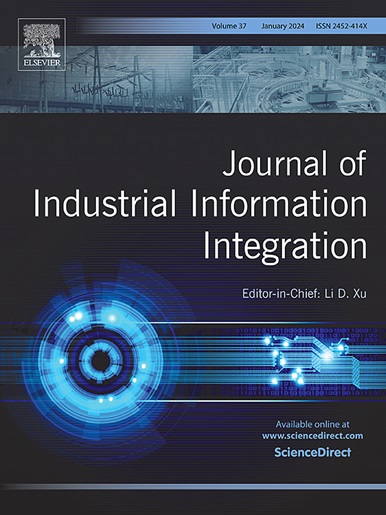Expert opinion aggregation-based decision support for human-robot collaboration digital twin maturity assessment
IF 10.4
1区 计算机科学
Q1 COMPUTER SCIENCE, INTERDISCIPLINARY APPLICATIONS
引用次数: 0
Abstract
Human-centered smart manufacturing is an essential direction for the future development of manufacturing. Safe and reliable smart human-robot collaboration is the foundation for realizing human-centered smart manufacturing. Digital twin-based human-robot collaboration has been proposed as a new manufacturing paradigm to devise collaborative strategies, simulate collaborative processes, and ensure worker safety. Establishing a maturity model is essential to accurately assess the capabilities of the constructed human-robot collaboration digital twin. This paper aims to contribute to the formalization and standardization of the human-robot collaboration digital twin. It constructs a novel assessment framework for the overall maturity measurement of existing digital twin-based human-robot collaboration projects. The developed human-robot collaboration digital twin maturity model includes 5 evaluation dimensions and 24 evaluation factors. Additionally, 5 maturity levels and their definitions are defined for each evaluation factor for maturity scoring. The expert opinion aggregation approach is proposed to quantify the evaluation factor metrics and ultimately to obtain a maturity level for the human-robot collaboration digital twin. The effectiveness and feasibility of the proposed method are verified through a collaborative assembly case study. This paper provides a generic method for assessing the competency level of human-robot collaboration digital twins, which can provide insights into the maturity of digital twins for practitioners in the human-robot collaboration field to develop targeted strategies for optimizing and upgrading human-robot collaboration digital twins.
基于专家意见汇总的人机协作数字孪生成熟度评估决策支持
以人为本的智能制造是未来制造业发展的重要方向。安全可靠的智能人机协作是实现以人为本的智能制造的基础。基于数字孪生的人机协作已被提出作为一种新的制造范式,用于设计协作策略、模拟协作过程和确保工人安全。建立成熟度模型对于准确评估所构建的人机协作数字孪生的能力至关重要。本文旨在促进人机协作数字孪生的正规化和标准化。它为现有基于数字孪生的人机协作项目的整体成熟度测量构建了一个新颖的评估框架。所开发的人机协作数字孪生成熟度模型包括 5 个评估维度和 24 个评估因素。此外,还为每个评估因素定义了 5 个成熟度等级及其定义,以便进行成熟度评分。提出了专家意见汇总法来量化评价因子指标,并最终得出人机协作数字孪生的成熟度等级。通过协作装配案例研究验证了所提方法的有效性和可行性。本文提供了一种评估人机协作数字孪生能力水平的通用方法,可为人机协作领域的从业人员深入了解数字孪生的成熟度,从而有针对性地制定优化和升级人机协作数字孪生的策略。
本文章由计算机程序翻译,如有差异,请以英文原文为准。
求助全文
约1分钟内获得全文
求助全文
来源期刊

Journal of Industrial Information Integration
Decision Sciences-Information Systems and Management
CiteScore
22.30
自引率
13.40%
发文量
100
期刊介绍:
The Journal of Industrial Information Integration focuses on the industry's transition towards industrial integration and informatization, covering not only hardware and software but also information integration. It serves as a platform for promoting advances in industrial information integration, addressing challenges, issues, and solutions in an interdisciplinary forum for researchers, practitioners, and policy makers.
The Journal of Industrial Information Integration welcomes papers on foundational, technical, and practical aspects of industrial information integration, emphasizing the complex and cross-disciplinary topics that arise in industrial integration. Techniques from mathematical science, computer science, computer engineering, electrical and electronic engineering, manufacturing engineering, and engineering management are crucial in this context.
 求助内容:
求助内容: 应助结果提醒方式:
应助结果提醒方式:


